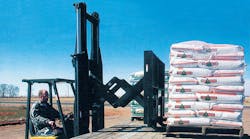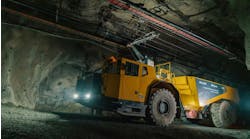Unless you work in the material handling or shipping industry, you probably think of a forklift as 4-wheeled vehicle that zips through warehouses unloading pallet-mounted cargo from trailers, loading cargo onto trucks, or moving freight around a warehouse to make room for more freight. Though this is an accurate description of the traditional warehouse forklift truck, more and more vehicles are moving from this convention to the truck-mounted, all-terrain forklift.
This file type includes high resolution graphics and schematics when applicable.
Two applications have driven this diversity in forklift truck design. First, outdoor warehousing has become commonplace, so the traditional 4-wheel truck with small tires and rear drive and steering proves unsuitable in many situations. Instead, forklift trucks that can tackle uneven terrain were developed to serve this need. Second, many companies need to load or unload cargo at facilities that have no forklift truck. For these cases, the lift truck is loaded onto the truck bed and transported with the freight to the destination. Once there, the lift truck lowers itself to the ground, then it moves the freight from the truck’s cargo bed to a specific area at the destination.
One particular model combines both of these features and more—all made possible by the innovative use of hydraulics. The lift truck features a 2-wheel hydrostatic drive (3-wheel optional) that not only provides propulsion, but speed control and braking as well. Steering is accomplished through a rear-mounted wheel that is positioned by a rotary actuator. As with most forklift trucks, the mast assembly is raised and lowered using hydraulics. But, in addition, this model incorporates a reach mechanism that is, essentially, a horizontally mounted double scissors jack. A pair of hydraulic cylinders actuates this mechanism to permit the fork assembly to reach loads positioned up to four feet in front of the lift truck.
HST Provides Propulsion and Safety
The hydraulic system of the lift truck is powered by a 46-hp (@2700 rpm) diesel engine driving an axial-piston pump for the hydrostatic transmission (HST). A tandem-mounted gear pump provides flow for steering, the mast assembly, and stabilizers. In the HST circuit, the variable-displacement pump delivers up to 46 cc/rev (2.8 in.3/rev) and has a maximum pressure rating of 350 bar (5000 psi). Output flow from the pump is routed to a parallel circuit feeding a pair of 35 cc/rev (2.14 in.3/rev) fixed-displacement, axial-piston motors. Each motor is connected through a splined shaft to a planetary wheel drive to rotate the front wheels at high torque.
The HST also incorporates a traction control system that can be engaged when the lift truck is operated under conditions that prevent the tires from getting good traction. The operator activates the traction control system through a switch, which routes hydraulic fluid through a flow divider-combiner. With the system activated, the divider-combiner valve routes hydraulic fluid equally to both wheels. This prevents the wheel with lower traction from spinning—often referred to as positraction.
Using the HST simplifies the design by providing not only propulsion, but braking as well. This eliminates the need for the many braking components that would otherwise be necessary if the vehicle used a mechanical drive. A spring-applied/pressure-released brake holds the lift truck in place when it is parked. A switch on the parking brake is wired to the engine’s electrical circuit to keep the engine from starting unless the brake is applied.
Rotary Actuator Simplifies Steering
Steering is accomplished though a third wheel mounted in the center-rear of the vehicle. (As an option, this wheel incorporates an axial-piston motor to provide 3-wheel drive.) This rotary actuator uses a piston-and-helix configuration to generate high torque through a full 180° rotation. The rotary actuator offers several advantages over a conventional steering cylinder and linkage setup. The rotary actuator:
• eliminates mechanical linkages and the maintenance associated with them
• exhibits constant steering effort throughout the full range of steering
• needs no periodic adjustment for wear
• achieves longer life
• is more compact
• provides more precise steering control
In addition to these benefits of using rotary actuators, the lift truck takes advantage of the rotary actuator’s pivot-style mounting. This mounting design incorporates integral bearings and a heavy-duty shaft and flange assembly, making it a self-contained steering actuator and wheel mount. Installation simply involves connecting the wheel assembly at the bottom, bolting the top flange of the actuator to the underside of the vehicle frame, and connecting the hydraulic lines.
An engineer for the lift truck manufacturer pointed out that precise steering control is important because designers wanted the vehicle to be easy to use. This is one reason why they decided against using a skid-steer drive arrangement. With skid-steer, steering is accomplished by varying the speed of the wheels on the left or right side of the vehicle.
In fact, rotating wheels forward on one side of the vehicle and in reverse on the other side allows the vehicle to turn on its own center. But because most operators would be accustomed to operating a conventional forklift truck, designers wanted their vehicle to have the steering feel of a conventional forklift. With the rear wheel positioned perpendicular to the front wheels, the Trailer Mate exhibits a turning radius of only 114 in., or 93 in. for the optional 3-wheel-drive model.
Far-Reaching Versatility
One of the most useful features of the lift truck is its reach mechanism. Essentially, this is a horizontally mounted scissors jack powered by a pair of hydraulic cylinders that extends the forks forward up to 48 in. This allows the vehicle to unload a truck entirely from one side of its cargo bed. Not only does this increase productivity, but it also improves safety because operators don’t have to venture out onto the traffic side of a truck to unload it. Also, if an operator needs to reach a loaded pallet that lies behind another one, he or she can extend the forks forward and above the obstacle to gain access to the load without having to move the pallet that’s in the way.
This file type includes high resolution graphics and schematics when applicable.
The lift truck is also designed for ease of maintenance, especially the hydraulic system. All hydraulic connections use O-ring face seal fittings to prevent leakage and simplify removal and replacement of components. To ensure reliability, the hydraulic system incorporates 2-µm filters in the HST circuit because it uses a piston pump and motors. Other circuits use a more dirt-tolerant gear pump, so 10-µm filtration has proven adequate. In addition, all maintenance checks can be performed from the right-hand side of the vehicle.



